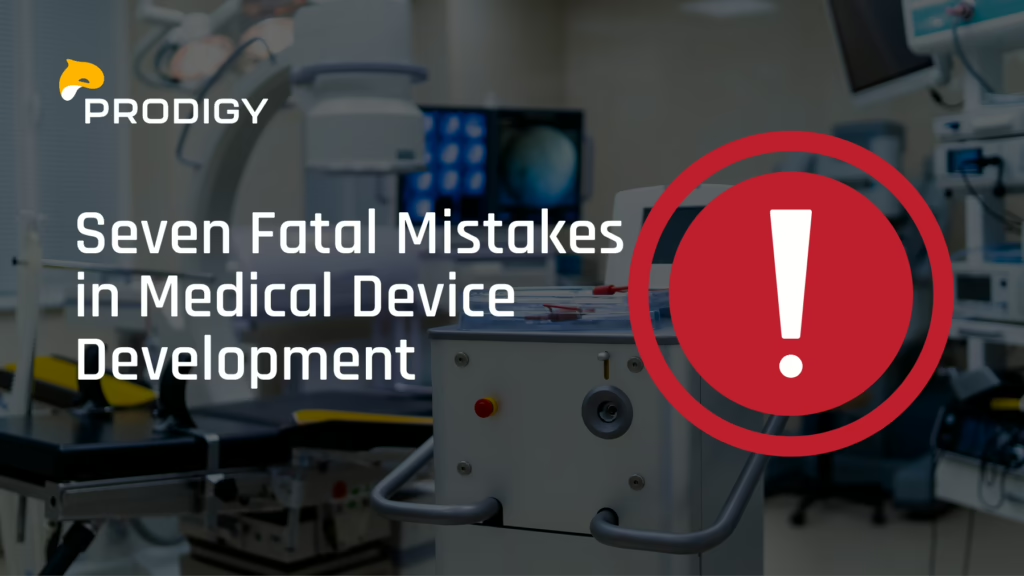Insights
Seven Fatal Mistakes in Medical Device Development

Is the development team of your medical device project aware of the most common and critical mistakes that are made? Despite the best efforts of development teams, these mistakes can derail a project, leading to increased costs, delays, market failure, and compromised patient safety.
By understanding and avoiding these pitfalls, development teams can significantly increase their chances of delivering reliable, effective, and user-friendly products that meet the evolving needs of the healthcare industry.
- Overcomplicating Device Designs
Designing an overcomplicated medical device can lead to numerous challenges, including increased costs, higher failure rates, and user frustration. Simple and elegant solutions are often superior because they are easier to use, more reliable, and cost-effective.
Here are just a few examples from other industries, to show the connection between simple, elegant design and product success:
Apple iPhone: The iPhone’s sleek design, intuitive interface, and seamless integration of hardware and software have set a standard in the smartphone industry.
Tesla Electric Vehicles: This line of electric cars combines cutting-edge technology with a minimalist design, offering easy-to-use controls and a luxurious driving experience.
Instant Pot: This multi-cooker combines several kitchen appliances into one, with a user-friendly interface and a sleek, modern design.
In a past medical device project, a surgical stapler to connect a blood vessel to the aorta during cardiac surgery was developed and sold. The device included extra functionality to make an incision in the aorta before stapling, which made the device quite large in the surgeon’s hand. The incision-plus-stapler architecture made the device unwieldy and awkward to use during surgery, and the increased complexity raised the risk of device malfunctions. It was not a success in the market.
| Simple can be harder than complex. You have to work hard to get your thinking clean to make it simple. -Steve Jobs |
- Neglecting Quality Control
Understanding and addressing user needs is crucial in the design and development process. By prioritizing user needs, product developers can create devices that are not only safe and effective but also user-friendly, enhancing the overall patient and healthcare provider experience. This holistic approach to quality helps build trust in medical devices and supports better healthcare delivery.
A comprehensive Quality Manual is essential, as it outlines the standards, procedures, and protocols that must be followed to maintain consistency and compliance with regulatory requirements. It serves as a guide for manufacturers to produce devices that meet stringent quality criteria.
Each medical device has a Design History File (DHF) which captures all the user needs and design inputs of the product development process, along with the verification and validation protocols and reports to show that these design outputs met the design inputs. Care in documenting DHF items is crucial to ensuring quality of the finished design.
Theranos Blood Tester: This is a cautionary story about the importance of quality and transparency in medical diagnostics. Theranos promised to revolutionize blood testing with its technology, claiming it could run hundreds of tests using just a single drop of blood. This attracted significant investment and high-profile endorsements. However, the company’s blood testing device failed to deliver accurate and reliable results. As a result, the Centers for Medicare & Medicaid Services (CMS) revoked Theranos’s certification for blood testing. The fallout from this story underscores the need for rigorous quality control in the development and deployment of medical devices.
- Failing to Lower the Total Cost of Care
Innovative medical devices tend to cost more than the devices that they are replacing, primarily as they are introduced. After market launch, cost reductions to the manufacturing processes and supply chain of new medical devices usually take months of engineering development and testing before they can be implemented. Some changes have regulatory implications, which adds additional time to the process.
While the initial cost of innovative new medical devices is often high, the long-term benefits of reduced complications, shorter hospital stays, and faster recovery can lead to overall cost savings for healthcare providers. The healthcare service industry, along with medical device manufacturers, has made substantial advancements in analyzing and estimating the total cost associated with new medical devices. Developers should be ready to participate in this total cost analysis and collect real-world data to support it.
Wise medical device companies that can accurately forecast sales volumes for up to 5 years in the future are able to budget appropriately for production equipment (e.g. multi-cavity injection molds) and achieve lower per piece cost for components.
- Not Involving Super-Users in Development
Top medical device companies prioritize involving physician advisors with extensive experience in their medical device projects. They understand that having a super-user on the development team can vastly improve device design. Super-users bring invaluable insights from their hands-on experience and deep understanding of practical applications, bridging the gap between theoretical design and real-world functionality. Their feedback ensures that the device is intuitive, efficient, and meets user needs, resulting in superior user experience.
Design engineers also benefit from repeated hands-on practice with the devices they are developing, evaluating them on the bench and in clinical lab settings. This practical experience is crucial, especially for surgical instruments like scissors, where performance can vary significantly. Surgeons who use these tools daily can detect subtle differences in performance and quality, highlighting the importance of real-world testing and feedback in the development process.
- Delaying Risk Analysis
Use-Related Risk Analysis (URA) and Failure Mode and Effects Analysis (FMEA) are both essential tools in the risk management process for medical devices, and both benefit projects the most when they are done as early as possible. The URA addresses user interaction risks, which is needed for high level design of the medical device. The FMEA focuses on technical failures, which guide designers as they develop individual components. In FMEA, severity measures the impact of a failure, occurrence assesses the likelihood of it happening, and detectability evaluates the probability of detecting it before it reaches the user. These factors are rated on a scale from 1 to 10 and multiplied to calculate the Risk Priority Number (RPN), which helps prioritize which risks need the most attention. The output of risk analysis has the most positive impact when it is available to the design team early in the design process. The risk analysis team needs to be cross-functional, with representatives from key areas, including design, manufacturing, quality, clinical, and regulatory.
EXAMPLE: A medical device design team developed an electrosurgical instrument with a single O-ring seal between two components to insulate patients from unintended electrical energy during surgery. FMEA analysis done late in development indicated that adding a second O-ring would further reduce the electrical risk RPN. However, since the design was finalized and production manufacturing tooling was already ordered, adding a second O-ring wasn’t practical. Instead, the team decided to electrically test 100% of assemblies on the assembly line to mitigate the risk, adding time and cost to manufacturing versus the cost of an extra O-ring.
- Ignoring the Care Team Experience
Medical device development teams must immerse themselves in the environments where their devices will be used, which may be hospitals, labs, or clinics. By both observing and listening, they can identify factors that contribute to the cognitive load on healthcare professionals. For example, in the operating room, the sterile table is meticulously organized with dozens of essential items; any new device must integrate into this setup. In labs and clinics, electronic devices often emit a variety of alarms, leading to user complaints about alarm fatigue and confusion from similar-sounding alerts. Developers need to thoughtfully consider the visual and auditory landscape to ensure their devices enhance, rather than hinder, the workflow and efficiency of healthcare teams.
Example: Laparoscopic cannulas incorporate a trapdoor mechanism and various seals in their construction. Some design teams have chosen transparent plastic for these devices, which is not the right design solution if the visible complexity of the device increases the cognitive workload of the user. Other factors, like being able to see fluids inside, may be the deciding factor for making a device transparent or opaque- this needs to be assessed carefully by the development team.
- Leaving Parts in Patient
Once in production, medical device manufacturers typically conduct a weekly review of adverse events. During these reviews, the complaints group shares details of complaints received from clinicians with the design and manufacturing teams. The most common serious complaint is Parts in Patient, which occurs when one or more parts of the device break off and remain inside the patient. If these parts cannot be located and removed, they can cause issues such as infection, inflammation, and tissue damage. This situation may necessitate additional surgeries, increasing the risk to the patient and the overall cost of their care.
To prevent Parts in Patient, it is crucial to create a thorough risk analysis and functional requirements document for the device early in the project. Parts with this potential risk must be carefully designed to withstand the loads they will experience and, whenever possible, be made radiopaque (visible on X-ray) so they can be seen and retrieved. For plastic parts, additives like barium sulfate can be incorporated into the plastic resin to make them radiopaque.
Summary
The development of medical devices is fraught with potential mistakes that can significantly impact their success and safety. From overcomplicated designs to leaving parts in patient, each mistake carries its own set of risks. Ensuring high quality, reducing the total cost of care, involving super-users in the development process, and conducting timely risk analyses are all critical steps in mitigating these risks. By focusing on simplicity, forward-thinking, and rigorous quality control, medical device developers can create products that not only meet regulatory standards but also enhance patient care and healthcare provider experiences. Ultimately, the goal is to avoid these mistakes and to deliver reliable, effective, and user-friendly medical devices that improve health outcomes and support the evolving needs of the healthcare industry.




